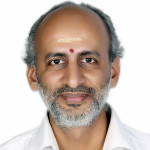 Presently he is Professor at IIT Bombay in the Cell for Indian Science and Technology in Sanskrit, Department of Humanitites and Social Sciences. Prof. Ramasubramanian holds a doctorate in Theoretical Physics, a Bachelors in Engineering, and a Masters in Sanskrit.
Presently he is Professor at IIT Bombay in the Cell for Indian Science and Technology in Sanskrit, Department of Humanitites and Social Sciences. Prof. Ramasubramanian holds a doctorate in Theoretical Physics, a Bachelors in Engineering, and a Masters in Sanskrit.Besides this, he has edited other works in Indian Astronomy and Mathematics, as well as authored several research papers, both individually and jointly with others. In 2008, he was conferred the prestigious award of Maharshi Badarayan Vyas Samman by the President of India in recognition of his scholarship as well as the outstanding research work done by him to the process of synergy between modernity and tradition. In 2010, the National Academy of Sciences India, honored him by conferring upon him the R. C. Gupta Endowment Lecture Award. He got elected as a Council member of the International Union of History and Philosophy of Science and Technology in the year 2013. He was a Member of the Second Sanskrit Commission formed by the MHRD, Government of India, in the year 2014, and is a Member of the Central Sanskrit Board formed in 2015.
Abstract of the talk
The use of language for communicating science has a very long and interesting history. In the ancient period in the West, Greek used to be the dominant language of both for ‘science’ and philosophy. The place of Greek was taken over by Latin during the late medieval and renaissance period. In due course, by around the beginning of twentieth century, Latin more or less diappeared as scientific language, and its position was equally shared between English, French and German. Moving ahead by a century, we find English reigning supreme as a medium of communicating science. As far as India is concerned, it is a different story.
It is a commonplace knowledge that Sanskrit was, and is the language of rituals and religious practices. It is also well known that it is the language in which great poets like Kalidasa and philosophers like Shankara have expressed their thoughts eloquently. What is not so well known is the fact that it has also been the language, in fact the most favoured one, in which scores of scientific literature has been created, be it in the field of astronomy, mathematics, physics, chemistry, economics, law, logic or medicine.
Though India is a multilingual country with dozens of languages—each spoken by millions of people and having their own scripts, vocabulary and grammar—it is remarkable that most of the literature, scientific or otherwise, has been composed in Sanskrit. Was it a deliberate choice or was it by compulsion? During our lecture, commencing with this question, we will try to explain what made Sanskrit the carrier of all categories of knowledge. We will then quickly move on to highlight how the astronomers and mathematicians, found several ingenious of representing numbers in order to integrate it them with verses. We will also demonstrate how successfully they could blend a variety of mathematical formulae, including the infinite series expansion of trigonometric functions, with beautiful poetry.
Video